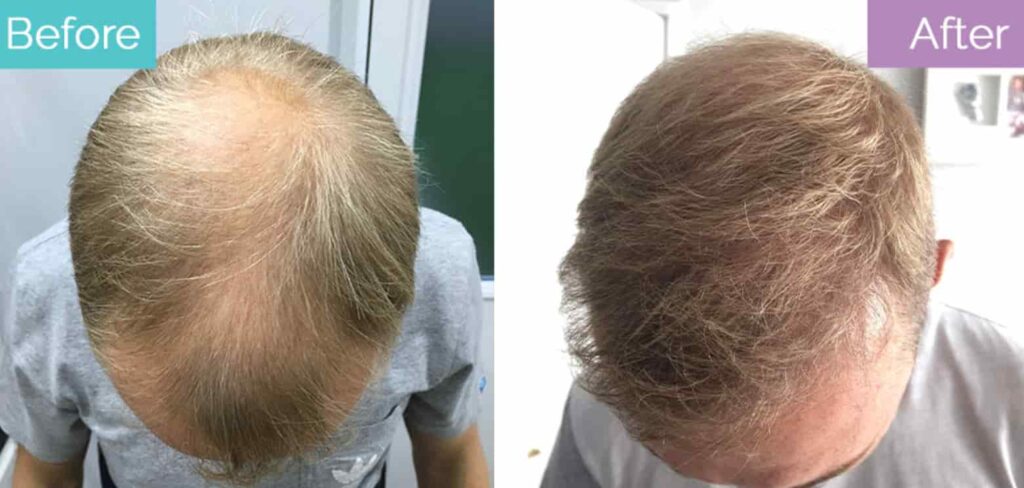A question that’s frequently asked with regards to restoration surgery is: do hair transplants turn grey? Considering how the colour of the hair is associated with youthfulness, greying can be a cause of concern among patients. Some even wonder whether the change in their hair colour is the result of the surgery itself.
In truth, a transplantation surgery does not change the natural hair colour. Going grey post-op is something you might experience regardless of whether you had surgery or not. This is because many people experience natural age-related hair greying. In some cases, however, grey hair can be indicative of another health condition.
Can Transplanted Hair Become Grey?
Transplanted hair can turn grey, but most likely due to reasons unrelated to the surgery. A hair transplant is based on the concept of “donor dominance,” which means that hair grafts retain the characteristics of the donor area even after they’ve been relocated to the balding areas of the scalp.
The donor area refers to the back and the sides of the side from where the hair is extracted and harvested for implantation. Since we don’t normally see the back of our heads as frequently as the front and top parts, it’s possible to be unaware of any grey hairs there until after they’ve been transplanted to the front.

Grey hair after a hair transplant can also be coincidental with other circumstances. For one, ageing naturally results in the greying of hair, also known as canities. According to Colorado State University’s Center for Healthy Aging, melanin, which is produced by melanocytes in hair follicles, is what gives the hair its characteristic colour. Ageing reduces the number of melanocytes, which results in the lowering of melanin production. Consequently, the hair becomes less pigmented, making it look silver-grey.
As reported in a 2020 review published in Skin Appendage Disorders, Caucasians are usually affected by it greying in their mid-30s, Asians in their late-30s and Africans in their mid-40s. But it can also occur prematurely and be considered so if it affects Caucasians younger than 20, Asians younger than 25 and Africans before 30. Some of the outlined causes of premature greying are as follows:
- Nutritional deficiencies (vitamin B12, iron, protein, copper)
- Vegan diet
- Being prone to developing allergic illnesses (atopy)
Other causes of hair greying can include conditions like vitiligo, alopecia areata, thyroid issues, UV radiation, smoking, and stress, among others. Of course, the genetics of an individual have also been largely implicated. In any case, you should consult with a medical professional for an accurate diagnosis.
Can A Hair Transplant Remove Grey Hair?
A hair transplant is meant to restore hair, so removing hair, even if it’s grey, would be counterintuitive to its goal. Keep in mind that a hair transplant draws on a limited store of donor hair at the back of your head.
According to a 2018 study published in the Journal of Cutaneous and Aesthetic Surgery, safely, around 6000 hair follicles can be extracted from the back of the head of an average person for a hair transplant.

It might sound like a lot, but in actuality, if you have experienced extensive hair loss, you can end up needing a large number of grafts (which can very well exceed 6,000). If too many grafts are removed from the back, it can leave the donor area permanently patchy.
Moreover, you should note that new grafts don’t grow out in place of those that have been extracted. Therefore, practically, you wouldn’t want to permanently remove perfectly healthy hair grafts even if they’re grey in colour.
Can Grey Hair Be Transplanted?
You can undergo a hair transplant surgery regardless of what colour your hair is. Grey hair can very well be transplanted, and you can achieve very satisfactory results with the procedure.

As highlighted by the International Society of Hair Restoration Surgery (ISHRS), it’s a misconception that grey hair is not healthy enough for a hair transplant. If that were the case, such hair wouldn’t be transplanted. But as it’s been seen, grey hair grafts can take very successfully and continue to grow like normal hair.
Can Hair Be Bleached After Hair Transplantation?
You can bleach your hair after a transplantation surgery, but your surgeon might advise you against it for a certain period of time. It’s because the harsh chemicals in bleaching agents might damage your scalp and the hair on it.
It’s possible that you might be advised to refrain from bleaching your hair for 6 months or so post-op, but only your surgeon can best inform you on this.
Conclusion
Do hair transplants go grey? Transplanted hair is your natural hair, so it can go grey as a result of different factors, such as ageing, genetics, nutrition, health problems, etc.
And keep in mind it’s also possible that the hair at the back of your head might already be greying without you noticing them. So, when they’re placed at the front after the surgery, you might think that it’s what changed the hair colour.
In any case, if you’re experiencing greying, you should consider getting in touch with a board-certified medical professional.
Reviewed and approved by Trichologist Yaprak Yazan



